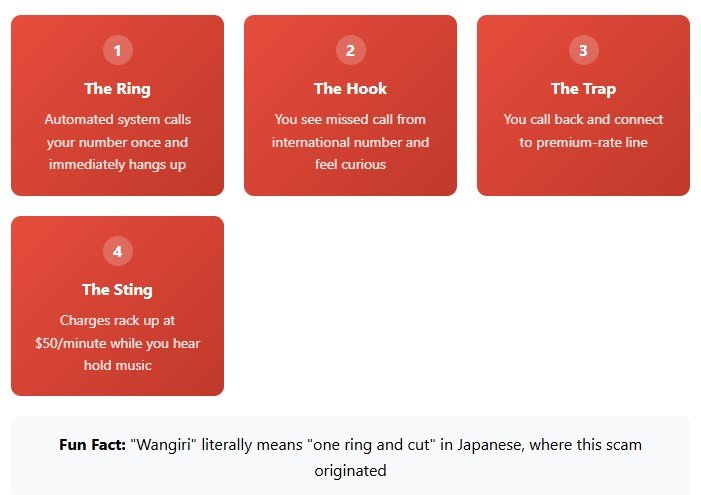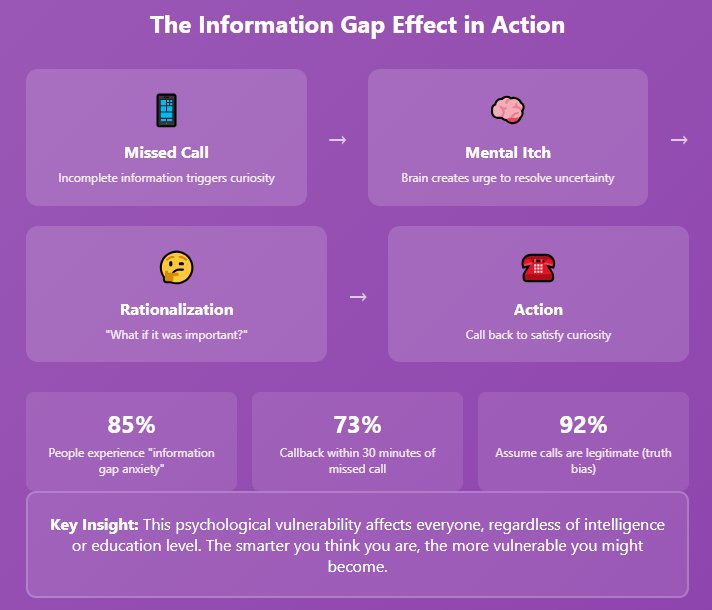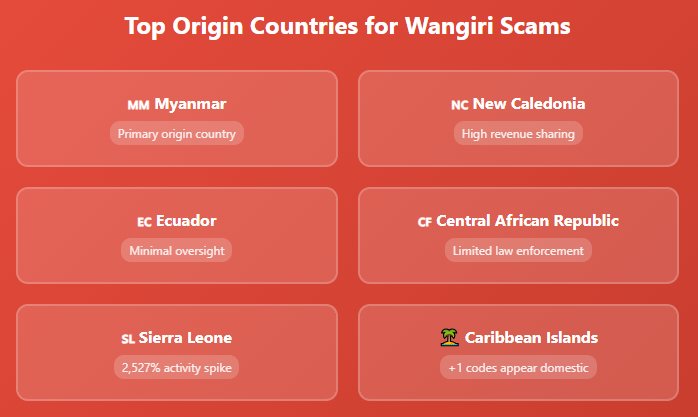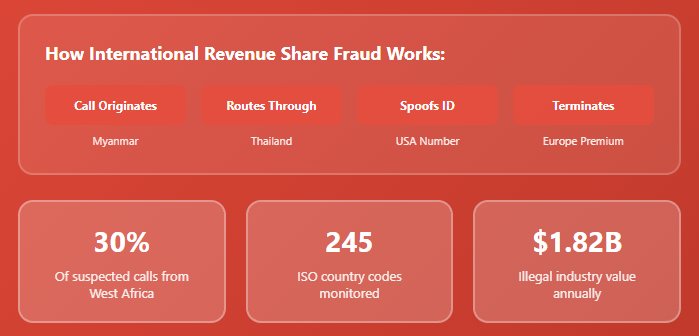
Your phone buzzes. One ring. Then silence. Sound familiar? If you’re like most people, that missed call is going to bug you. You’ll probably think it was important. Maybe even call back.
Big mistake. That single ring could be the opening move in a scam that’s been quietly draining billions from unsuspecting victims worldwide. And here’s the kicker – it’s not just targeting your grandmother anymore.
What Exactly Is This “One-Ring” Scam?

Let me paint you a picture. You’re going about your day when your phone rings once and stops. The number looks foreign – maybe from Sierra Leone or Myanmar. Your curiosity gets the better of you, so you call back.
The moment that call connects, you’re on the hook for premium charges that can cost up to $50 per minute. Yes, you read that right. Fifty dollars. Per minute.
This scheme has a name: Wangiri (pronounced “wahn-GEE-ree”), which means “one ring and cut” in Japanese. It’s been around for decades, but it’s evolved into something far more sophisticated and dangerous than anyone imagined.
The Numbers That’ll Make Your Head Spin

Here’s what should keep you up at night: this scam generates $2.23 billion in losses annually. That’s just what telecom companies lose directly – it doesn’t even count what individual victims pay.
In early 2020, Wangiri activity surged by 98%. During one particularly busy day in May, calls from Sierra Leone alone jumped by 2,527%. That’s not a typo.
Alex Algard, CEO of Hiya (a company that analyzes over 13 billion calls monthly), puts it perfectly: “By letting the one ring scam die down for a few years while they targeted victims in other countries, these criminals hope that Americans forgot their tactics.”
Spoiler alert: it worked.
Why Your Brain is Hardwired to Fall for This

Here’s the uncomfortable truth – this scam works because it exploits something fundamental about human psychology.
Scientists call it the “information gap effect.” Basically, when we encounter incomplete information (like a missed call), our brains create an almost irresistible urge to fill in the blanks. That single ring creates what researchers describe as a “mental itch that demands scratching.”
Think about it. How many times have you gotten a missed call and immediately thought:
- “What if it was important?”
- “What if someone needs help?”
- “What if I’m missing something?”
Scammers are counting on exactly this reaction.
The Victims Aren’t Who You Think
Most Vulnerable Age Groups
Surprising Risk Factors
Pop quiz: who do you think falls for these scams most often?
If you guessed “elderly people,” you’d be wrong.
Recent research shows that young adults aged 20-39 are highly vulnerable to one-ring scams. Even more surprising? Higher education levels can increase your chances of falling for it.
Why? Overconfidence. Smart people often think they’re too clever to fall for scams, which makes them less cautious when they should be most alert.
I’m not making this up – a Harvard PhD economist fell victim when fraudsters combined one-ring tactics with fake bank security calls. If it can happen to someone with a doctorate from Harvard, it can happen to anyone.
How the Modern Version Will Blow Your Mind

The original Wangiri was pretty straightforward: call once, hope someone calls back, profit.
But today’s scammers? They’ve gone full sci-fi.
Meet “Wangiri 2.0”
Instead of just targeting your phone, these criminals now use automated bot networks to fill out contact forms on business websites. They submit premium-rate callback numbers disguised as customer inquiries.
Here’s the genius (and terrifying) part: businesses are programmed to respond quickly to customer requests. Their automated systems dutifully call back what appears to be a legitimate customer inquiry, racking up massive bills in the process.
One architectural firm discovered a $166,000 fraudulent bill after their callback system repeatedly dialed premium numbers submitted through their online contact form.
The AI Arms Race
Modern Wangiri operations can execute up to 300,000 one-ring calls daily using artificial intelligence to:
- Analyze optimal timing for calls
- Target specific geographic areas
- Spoof caller IDs to look local
- Maximize callback rates while avoiding detection
Meanwhile, the good guys fight back with equally sophisticated AI that analyzes over 200 different traffic parameters to spot fraudulent patterns. It’s like a high-tech game of cat and mouse, except the stakes are billions of dollars.
The Global Fraud Highway System

Here’s something that’ll make you think twice about international calls: Wangiri operates along what experts call “global fraud highways.”
These aren’t random routes. Scammers carefully select countries based on:
- Minimal regulatory oversight
- High revenue-sharing rates
- Limited law enforcement cooperation
Myanmar currently leads the pack as the primary origin country, followed by New Caledonia, Ecuador, and the Central African Republic.

But here’s where it gets sophisticated: a single scam call might originate in Myanmar, route through Thai infrastructure, spoof a US caller ID, and terminate at a premium number in a European territory. This creates a jurisdictional nightmare for law enforcement while generating “frictionless” profits for criminals.
What Happens When You Call Back (Spoiler: Nothing Good)

Let me walk you through exactly what happens when you fall for this scam.
You see that missed call. Your curiosity kicks in. You dial back.
The moment your call connects, you’re not just making an international call – you’re entering what’s called “International Revenue Share Fraud” (IRSF). The charges get split between phone companies and number owners, with fraudsters receiving substantial portions of those inflated costs.
Think of it like this: you’re essentially calling a premium phone sex line, except instead of adult entertainment, you get dead silence or endless hold music while your bill climbs by the minute.
The technical term for this pricing manipulation is “geographic rate arbitrage.” Rate differences can exceed 70 times the normal cost based solely on where the call appears to originate.
The Industry Fights Back (Finally)
Major Industry Responses to Wangiri Fraud
The good news? The telecommunications industry isn’t just sitting around counting losses.
The TRACED Act Revolution
In 2019, the TRACED Act gave phone companies unprecedented power to block suspicious calls without requiring you to opt out first. The FCC finally acknowledged that “one-ring scam calls serve no beneficial purpose.”
About time, right?
STIR/SHAKEN Technology
This sounds like a James Bond cocktail order, but STIR/SHAKEN is caller ID authentication technology. Verizon alone protected 78 million customers from over 13 billion spoofed calls using this system.
Acting FCC Chairwoman Jessica Rosenworcel calls it a “turbo-charge” for anti-robocall tools, though experts acknowledge it’s not a complete solution.
AB Handshake’s 99.995% Solution
Some companies are getting creative with detection. AB Handshake developed cross-validation technology that achieves 99.995% accuracy in detecting Wangiri calls by cross-checking call details between networks using encrypted messages.
Think of it as a “zero-trust” approach – every call is guilty until proven innocent.
How to Protect Yourself (It’s Easier Than You Think)

The best defense against Wangiri scams? Don’t call back numbers you don’t recognize.
I know, I know. Easier said than done when your brain is screaming, “But what if it was important?”
Here’s your action plan:
The Golden Rules
- If it was truly important, they’ll call again – or leave a voicemail
- Google the number first – many scam numbers are already reported online
- Be extra suspicious of international numbers – especially from countries you have no connection to
- Use call-blocking apps – Hiya, Truecaller, and others can identify suspicious numbers
Red Flags to Watch For
- Single ring, then immediate disconnect
- International numbers (especially from Myanmar, Sierra Leone, or Caribbean islands)
- Numbers that call multiple times but never leave voicemails
- Calls that come in rapid succession from similar numbers
If You’ve Already Called Back
Don’t panic. Here’s what to do:
- Hang up immediately if you realize what’s happening
- Contact your phone carrier to report the fraudulent charges
- Monitor your next bill carefully for unexpected international charges
- File a complaint with the FCC at consumercomplaints.fcc.gov
The $40 Billion Question
Here’s the bigger picture that should concern all of us: Wangiri is just one piece of a massive fraud ecosystem that cost the telecommunications industry $38.95 billion in 2023 – a 12% increase from 2021.
That’s not just numbers on a corporate balance sheet. Those losses get passed down to consumers through higher fees, reduced services, and the constant hassle of dealing with fraud protection measures.
The Communications Fraud Control Association found that telecom operators spend an additional $430 million annually just compensating customers for fraudulent charges. Add in customer churn, brand damage, and the cost of fraud detection systems, and we’re talking about billions more in indirect costs.
The Human Element That Never Changes
Here’s what fascinates me about the Wangiri phenomenon: despite decades of consumer education, billions in losses, and sophisticated detection systems, the fundamental vulnerability remains unchanged.
Human curiosity.
We can build all the AI-powered defenses we want, implement blockchain verification systems, and create international law enforcement task forces. But as long as humans remain curious about missed calls, there will be criminals ready to exploit that curiosity.
Steve Legge, CEO of netnumber, captures this perfectly: “The bad guys only need to get it right once. The good guys must get it right 100% of the time.”
What This Means for Your Daily Life
The uncomfortable truth is that this scam succeeds not despite our connected world, but because of it. The same international billing systems and seamless call routing that let you talk to anyone, anywhere, also create opportunities for sophisticated fraud.
Every time you get a missed call from an unknown number, you’re facing a split-second decision that could cost you hundreds of dollars. Your curiosity – that fundamental human trait that drives innovation and connection – becomes a weapon in the wrong hands.
The Bottom Line
The one-ring scam has evolved from a simple Japanese curiosity trap into a $2.23 billion global fraud network. It targets everyone from Harvard economists to your tech-savvy nephew, using artificial intelligence and psychological manipulation to turn your natural human curiosity against you.
The scariest part? It’s getting more sophisticated every day.
But here’s the thing – now you know. You understand how it works, why it works, and most importantly, how to protect yourself.
The next time your phone rings once and stops, remember this article. Take a deep breath. Resist that urge to call back. Because sometimes, the most important call you can make is the one you choose not to make. Your wallet will thank you.






